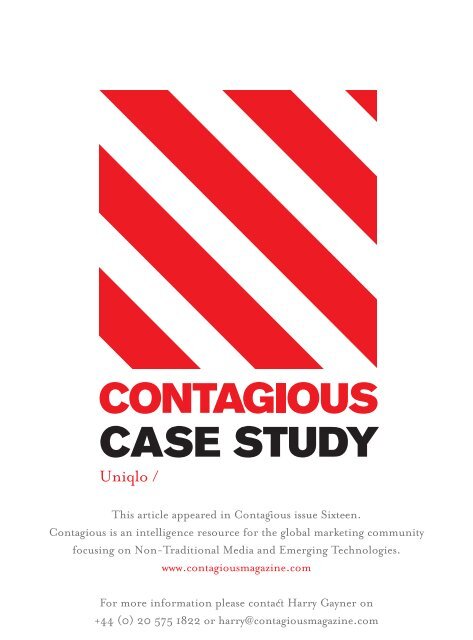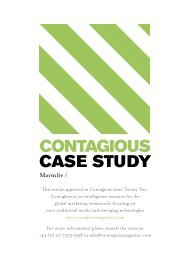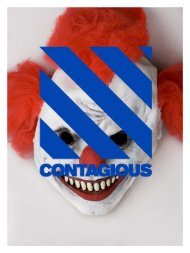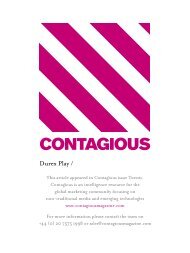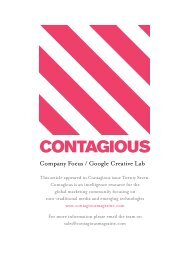CASE STUDY Uniqlo - Contagious Magazine
CASE STUDY Uniqlo - Contagious Magazine
CASE STUDY Uniqlo - Contagious Magazine
You also want an ePaper? Increase the reach of your titles
YUMPU automatically turns print PDFs into web optimized ePapers that Google loves.
<strong>CASE</strong> <strong>STUDY</strong><br />
<strong>Uniqlo</strong> /<br />
This article appeared in Contagous issue Sixten.<br />
<strong>Contagious</strong> is an intelligence resource for the global marketing community<br />
focusing on Non-Traditional Media and Emerging Technologies.<br />
www.contagiousmagazine.com<br />
For more information please contac Harry Gayner on<br />
+44 (0) 20 575 1822 or harry@contagiousmagazine.com
case study / uniqlo /<br />
FOUND IN TRANSLATION
70 / 71<br />
<strong>CASE</strong> <strong>STUDY</strong> / UNIQLO / FOUND IN<br />
TRANSLATION / THERE IS MORE TO<br />
UNIQLO’S BRAND STORY THAN COOL<br />
CELEBRITY COLLABORATIONS AND<br />
CASHMERE CUDDLES. A CLOSE BRUSH<br />
WITH BANKRUPTCY DEMONSTRATED THAT<br />
THE ONE SIZE FITS ALL BUSINESS MODEL<br />
THAT THRIVED IN A RECESSION-STRUCK<br />
JAPAN WOULD NEED TAILORING TO FIT<br />
THE FICKLE WESTERN RETAIL<br />
ENVIRONMENT. OPERATING WITH A<br />
FRESH AND FLEXIBLE NEW BRAND<br />
IMAGE SUPPORTED BY AWARD-WINNING<br />
INTEGRATED MARKETING CAMPAIGNS,<br />
THE DEVELOPMENT OF THE UNIQLO<br />
COMMUNITY IS NOW A THOROUGHLY<br />
MULTI-CULTURAL, MULTI-PLATFORM AFFAIR.<br />
I THINK WE’RE TURNING JAPANESE –<br />
I REALLY THINK SO… / BY WILL SANSOM /
case study / uniqlo /<br />
It could be a pair of pants. Perhaps it's a cashmere<br />
sweater, or maybe even a T-shirt sporting a mean n' moody<br />
Manga-inspired design. Whatever it is, chances are that<br />
you own at least one item of UNIQLO clothing. If not, it's<br />
only a matter of time until you do.<br />
Officially Japan's leading clothing retail chain, UNIQLO<br />
currently has 804 stores worldwide, the sales from which<br />
have encouraged parent company Fast Retailing Co. Ltd<br />
to reveal optimistic forecasts for the fiscal year of 2008<br />
of ¥585bn (€3.5bn) in net sales. Indeed, in June, Fast<br />
Retailing reported a five-year record high share price of<br />
¥9860 (€59). With this in mind, the chances of this<br />
financial target for 2008 being met, are almost as likely<br />
as that pair of pantone-perfect socks winding its way<br />
into your top drawer by the end of the year…<br />
However, like all the best success stories, the UNIQLO<br />
saga is not without its share of adversity. Initial attempts<br />
to replicate UNIQLO's quintessentially Japanese business<br />
model in the western retail environment did not go exactly<br />
to plan and after failed expansion in 2001, the brand<br />
was forced to retreat and regroup. It would seem that a<br />
different methodology would need to be adopted if what<br />
started out as a single unisex clothing store in Hiroshima<br />
was to be successfully rolled out on a global scale.<br />
From tiny warehouses<br />
The UNIQLO brand philosophy has always been about<br />
creating a distinctly utilitarian retail experience for<br />
consumers. Normal concerns held by the average<br />
shopper about style, quality and brand are dissolved by<br />
a simple assurance that whatever they buy, it will be<br />
great quality, low in cost and will look good with<br />
anything and everything they decide to wear it. What<br />
UNIQLO does therefore, is to provide the basic but<br />
premium ingredients of your wardrobe.<br />
The 'Unique Clothing Warehouse' was opened in 1984<br />
by the Yamaguchi-based Ogori Shoji, which, since 1949,<br />
had operated a chain of clothing stores called 'Men's<br />
Shop OS'. However, the simple difference of stocking<br />
unisex clothing was enough to ensure that the success<br />
of the new store far eclipsed that of the existing outlets.<br />
Ogori Shoji was changed to the somewhat catchier<br />
'Fast Retailing' and in turn, its rapidly expanding new<br />
chain became UNIQLO. By April 1994, over 100 stores<br />
had been opened across Japan and to meet this new<br />
demand, in 1997 UNIQLO adapted the SPA (Specialty<br />
Store of Private Label Apparel) model which had proved<br />
so successful for US retail giant Gap; instead of selling<br />
proprietary clothing, UNIQLO would now exclusively<br />
produce and carry its own garments. The out-sourcing<br />
of the manufacturing process to more affordable<br />
factories in China enabled the brand to capitalise on this<br />
business model, providing great value clothing that was<br />
snapped up by the Japanese public in the clutches of a<br />
recession.<br />
In 2001, the first overseas UNIQLO outlets were opened<br />
in Shanghai and shortly after, four more in London.<br />
However, poor execution of this expansion meant that<br />
the brand was met with indifference by the UK public.<br />
Simon Coble, UNIQLO UK, CEO, elaborates: 'We opened<br />
without a flagship store and expanded our network with<br />
a scattergun approach very quickly, before we stabilised<br />
operations. Opening stores in Romford and Knightsbridge<br />
wasn't, in hindsight, the best approach as the brand wasn't<br />
solidified and we failed to support our outer London stores<br />
with the marketing that they required.' Marino Donati,<br />
news editor for fashion publication Drapers, adds: 'In the<br />
UK, you've really got to shout about your identity in order<br />
to be heard. On the one hand, retailers such as Zara and<br />
Topshop were practising fast fashion with a quick<br />
turnover of lines, whilst on the other, retailers like Primark<br />
and Tesco had the budget end of the market cornered.<br />
Occupying a space somewhere in the middle, UNIQLO<br />
was something of a lost sheep.'<br />
However, what doesn't kill a brand only makes it stronger,<br />
and over the following three years concerted efforts were<br />
made to revive and repair the struggling business. In<br />
Japan, the solution was born out of a realisation that the<br />
standalone SPA business model referred only to<br />
production and sales. Accordingly, UNIQLO embarked<br />
upon a far more collaborative approach to its branding<br />
and advertising; rather than enlisting any one agency,<br />
key figures from different creative disciplines were<br />
recruited to collaborate on, and rejuvenate every aspect<br />
of the brand. Kashiwa Sato – executive creative director,<br />
Samurai, Tokyo, oversaw the process as well as taking<br />
care of graphic work such as the redesigned logo which<br />
would be used on store facades, marketing materials and<br />
the products themselves. Markus Kiersztan – creative<br />
director, MP Creative, NY handled in-store visuals and<br />
communication strategies, whilst digital supremo Yugo<br />
Nakamura of tha* ltd. Tokyo used his quirky Flash genius<br />
to revamp UNIQLO's online presence and enhance the<br />
digital element of the ensuing campaigns.<br />
In keeping with this new approach, changes were<br />
being subtlety implemented and experimented within<br />
the remaining UK stores – Simon Coble expands: 'We<br />
realised that we had a loyal following in the UK and there<br />
was a definite bubbling interest in the right demographics<br />
– so we had to be careful to keep the niche element and<br />
attraction to the brand that appealed to this audience,<br />
whilst at the same time retaining our "bread and butter"
contagious<br />
72 / 73
case study / uniqlo /<br />
customers in the suburban stores.' UNIQLO, it would<br />
seem, was once again ready for a stab at globalisation<br />
– combining what it had learnt from the UK with the fresh<br />
and most importantly, considered new brand identity.<br />
From Tokyo to NYC<br />
In November 2006, UNIQLO opened its global flagship<br />
store in the SoHo fashion district of Manhattan. Prior to<br />
the opening, several shipping containers were hoisted –<br />
via crane and flat bed truck – into selected locations<br />
around New York. Powered by an external generator,<br />
these temporary outlets contained neatly folded stacks<br />
of clothing and gave a glimpse of the kind of utilitarian<br />
perfection preached by the brand. However, once the<br />
store itself opened, it would become apparent that this<br />
sense of utility had been perfectly blended with a fresh,<br />
cosmopolitan feel – every bit in keeping with its highprofile<br />
location. Designed by renowned architect<br />
Masamichi Katayama of Wonderwall, Tokyo, the 36,000<br />
square foot space epitomises a carefully constructed<br />
juxtaposition between the brand's Japanese heritage<br />
and a contemporary, culturally inclusive retail experience.<br />
Scott Kraenzlein, account executive with MP Creative,<br />
emphasises the challenge encountered when striking a<br />
balance with the new store: 'UNIQLO has always been<br />
more about a service than a fashion brand; however,<br />
your average Manhattan shopper is not only extremely<br />
style conscious, but also has higher expectations of<br />
what a retail experience should encompass. Above all,<br />
simplicity is key and the clothes are given the space to<br />
speak for themselves, allowing customers to become<br />
acquainted with the brand at their own pace.'<br />
One device used to introduce the UNIQLO philosophy<br />
to New Yorkers, was the UNIQLO Paper, conceived by<br />
MP Creative. Distributed in-store and available online via<br />
a Flash-enabled application, the free magazine features<br />
interviews with designers, local celebrities and artists,<br />
illustrating the cultural relevance of the brand. 'We<br />
wanted to create a magazine that was more than the<br />
standard look-books you get at other stores,' explains<br />
Marcus Kiersztan, 'We wanted to align the brand with<br />
the art and design industry.'<br />
A large in-store gallery was used to exhibit a range of<br />
over 100 limited-edition, exclusive T-shirt designs from<br />
over 40 artists including Yayoi Kusama, Tezuka and<br />
Godzilla. This space was then used from Spring 2007<br />
to house products featuring in the first installment of the<br />
UT Campaign. Yet another example of a distinctly<br />
Japanese retail device being tailored for a global market,<br />
the project rode on the back of the phenomenal success<br />
of the exclusive UT Store in Harajuku, Tokyo. This shop,<br />
devised by Kashiwa Sato, sells limited-edition T-shirts<br />
packaged in plastic tubes on open shelves, providing a<br />
super-efficient self-service system that is more Japanese<br />
convenience store than fussy fashion retailer. The<br />
campaign was supported by print, poster and in-store<br />
advertising, featuring portraits by renowned fashion<br />
snapper Terry Richardson. In spring 2008, the project<br />
launched again on a global scale, this time with Brit Matt<br />
Irwin shooting 300 street-cast models in Tokyo, New<br />
York and London.<br />
The success of the new formula in NYC proved that<br />
UNIQLO was finally striking the right balance for the<br />
western retail environment. Kensuke Suwa, UNIQLO<br />
global marketing director, comments on the expansion:<br />
'Each new territory spells new challenges as we move<br />
towards becoming a truly global brand – be they internal<br />
or external factors. However, after the lessons we learnt<br />
back in 2001, we now approach each new market<br />
tentatively and look to gain a solid understanding prior to<br />
large scale-commitment.'<br />
London calling<br />
Clearly, whatever had originally been lost in translation<br />
was finally being found. One year on from the opening<br />
of the global flagship store in New York, the brand was<br />
once again ready to tackle its territorial Achilles heel and<br />
take on the UK fashion market right where it is distilled<br />
to its most competitive and fickle – the high street. And<br />
what better high street to take on, than Oxford Street in<br />
central London? With over 200m visitors and 300 retailers<br />
taking approximately £5.5bn (€7bn) every year, this is<br />
one of the busiest retail environments in the world.<br />
The same collaborative process that gave birth to the<br />
NY store was employed in the design and execution of<br />
not one, but two new stores which opened simultaneously<br />
at either end of Oxford Street in November 2007. The<br />
larger of the two premises (nearer the more up-market<br />
Mayfair area) is the official European UNIQLO flagship<br />
store, echoing in terms of interior design and architecture,<br />
many of the features found in the New York location.<br />
Four huge revolving mannequin boxes reach up to the<br />
first floor, displaying the current seasonal offerings and<br />
for the first time outside Japan, a dedicated UT 'future
contagious<br />
74 / 75
case study / uniqlo /<br />
convenience store' section has been created with the<br />
shelf-stacked 'T's in tubes' layout of the Harajuku shop.<br />
The re-birth of the brand in the UK was promoted not<br />
only by the 2008 incarnation of the UT T-shirt project,<br />
but also by a more cohesive version of the People<br />
campaign – first devised for the New York launch by<br />
Marcus Kiersztan of MP Creative, and Nicola Formichetti,<br />
creative director of Dazed & Confused. Focussing on<br />
local heroes and celebrities as brand advocates, the<br />
success of this egalitarian campaign relied heavily on it<br />
being adapted for each specific location. Therefore for<br />
London, home-grown British talent was featured such<br />
as eclectic rapper Dizzee Rascal, who also performed at<br />
the opening of the stores. Kensuke Suwa concludes:<br />
'When launching the London flagship store, the strap<br />
line "From Tokyo to London" reinforced the idea that the<br />
brand was Japanese, but by working with British talent<br />
such as Bobby Gillespie of Primal Scream, actress<br />
Samantha Morton and Georgia Jagger, we created a<br />
campaign specifically for London that would resonate<br />
with Londoners.'<br />
Building global communities online<br />
Considering the size and location of UNIQLO's flagship<br />
stores, one could be forgiven for presuming that<br />
globalising the brand has thus far been a strictly<br />
territorial, real-world affair. However, looking at the most<br />
successfully integrated of the brand's advertising and<br />
marketing campaigns, it soon becomes clear that<br />
encouraging consumers to interact with the brand in a<br />
digital environment has played just as big a part – if not<br />
bigger – in helping the UNIQLO community to expand<br />
and transcend cultural boundaries.<br />
Yugo Nakamura, as well as forming part of UNIQLO's<br />
Creative Committee, is creative director at tha* ltd. – the<br />
agency responsible for some of the brand's most<br />
innovative digital campaigns such as UNIQLO GRID and<br />
UT LOOP. 'With all of the UNIQLO online campaigns, the<br />
basic question is how to deepen and broaden the users'<br />
brand experience. The challenge is then to achieve this<br />
through encouraging user participation, by creating and<br />
visualising a space where users can actively interact<br />
with the campaign. This isn't to say that everything is<br />
dependent on the activity of the users; what is important,<br />
is to keep the balance between places where users can<br />
be passive and places where they can be active.'<br />
Designed to reflect how the brand is constantly evolving<br />
in the hands of the consumer, UNIQLO GRID allows<br />
users on a dedicated microsite to manipulate the UNIQLO<br />
logo by using the mouse pointer to click, drag, spin and<br />
multiply to their hearts' content. However, the digital<br />
canvas on which they play with the logo is shared by<br />
thousands of users across the world – making this a<br />
genuinely collaborative exercise. At the top of the page,<br />
it tells you exactly who (by nickname) is making which<br />
moves. At the time of writing, Mako in Japan was<br />
furiously multiplying in diagonals across the bottom of the<br />
screen…<br />
For a slightly trickier but ultimately more rewarding<br />
creative process, check out the UNIQLO UT LOOP – part<br />
of the UT T-shirts campaign. Originally running alongside<br />
a series of TV spots, this Flash-enabled site provides<br />
you with nine different UNIQLO representatives, each<br />
with their own sample noise, be it a shout, grunt or even<br />
a big ol' fashioned raspberry. You can then drag and<br />
drop the different characters, complete with noises, into<br />
sixteen different spaces, thereby creating your very own<br />
mini dub loop. Once you are happy with how it sounds,<br />
you can submit your loop to the website, where it will be
shuffled and played at random as part of the 'People's<br />
Loop'. There is even an easy 'Blog this' button which<br />
allows visitors to download and share either this<br />
collaborative loop or just their own, as a widget for<br />
embedding on blogs or external websites. Yugo<br />
Nakamura concludes: 'Rather than being at the centre of<br />
fashion trends, UNIQLO has a philosophy of providing<br />
the high quality components of fashion. Respectively,<br />
UNIQLO GRID and UT LOOP both encapsulate this<br />
idea of combining simple elements into a complex and<br />
freeform variety.'<br />
Clicks and clocks<br />
There is of course, a campaign masterminded by Projector,<br />
Tokyo which took the interactive and monstrously<br />
addictive flash site model to a whole new level in 2008.<br />
It has scooped thus far, the Innova Lotus Gold Award at<br />
ADFEST, 2 Gold Awards and the Grand Prix at the One<br />
Show Interactive, a Grand Clio for Interactive, a D&AD<br />
Black Pencil for Online Advertising as well as a Cyber<br />
Lions Grand Prix and the prestigious <strong>Contagious</strong>sponsored<br />
Titanium Lion award at Cannes 2008. Ladies<br />
and gentlemen, we give you the UNIQLOCK.<br />
Mark Tutssel, chief creative officer, Leo Burnett<br />
Worldwide, was the Cannes 2008 Titanium and<br />
Integrated jury president. He describes the impact which<br />
the UNIQLOCK had on the judges: 'A Titanium Lion is<br />
an idea that's so unique, pure and new it cannot be<br />
labelled in a conventional way. It breaks through traditional<br />
contagious 76 / 77<br />
award-category boundaries and creates something<br />
altogether better. Titanium is about finding tomorrow's<br />
ideas that reset the creative bar and move the industry<br />
forward. The UNIQLOCK was an idea that stopped the<br />
jury dead in its tracks. An idea that fused together<br />
everything that is new in our business: entertainment,<br />
utility and interactivity. After all, only with innovative and<br />
ground-breaking thinking can we adapt to the speed at<br />
which the world is changing. This is virtual, branded<br />
utility – pure Titanium.'<br />
The 2008 campaign is a development of a 2007<br />
initiative – an online clock which marks passing moments<br />
with 5-second clips of female dancers performing<br />
micro-routines clad in the new UNIQLO line of<br />
cashmere. Somewhere between branded entertainment<br />
and utility, this delightfully distracting microsite struck a<br />
chord with bored office workers everywhere; it racked<br />
up over 30m views in 195 countries – highly significant<br />
considering that the brand has stores in only a handful<br />
of these territories.<br />
Recognising the brand-building potential of the<br />
application, Projector set about making it bigger and<br />
better for 2008. As a result, it now operates 24/7 for<br />
365 days a year, with the dancers' clothes changing<br />
according to each season – polo shirts in spring and<br />
cashmere sweaters in the winter. It will also go to sleep<br />
at night, with sequences on the hour and an alarm clock<br />
function in case you're in the habit of keeping your<br />
laptop next to your bed. Perhaps most significantly<br />
however, a downloadable version of the UNIQLOCK is<br />
now available as a widget for embedding on blogs,<br />
iGoogle or Facebook profiles. By viewing WORLD.<br />
UNIQLOCK, users can link to all the embedded sites via<br />
a global map which lets you see at any given time,<br />
exactly how many people are watching the UNIQLOCK<br />
and in what country. This is perhaps the most literal<br />
realisation of the UNIQLO global community to date –<br />
proven by the fact that so far, over 27,000 widgets have<br />
been downloaded and the site itself has been viewed<br />
68m times in over 209 countries.<br />
'I had the intuition that an expression which perfectly<br />
synchronised bodily movements with sound, would be<br />
the most simple and pure way of representing<br />
UNIQLO's products. The concept of MUSIC X DANCE<br />
X CLOCK came from the "rhythm of a second" – dance
case study / uniqlo /<br />
to the rhythm of a second and music to the rhythm of a<br />
second – in the same way that a clock keeps time to the<br />
rhythm of a second. After Googling the name "UNIQLOCK"<br />
and finding zero results, I knew straight away that this<br />
tag would be perfect for spreading the experience<br />
across the web and uniting global bloggers,' says<br />
Koichiro Tanaka, creative director, Projector, Tokyo.<br />
Since the UNIQLOCK, Projector has continued to study<br />
the behavioural patterns of internet users – concentrating<br />
on that initial moment of uptake and how content is<br />
absorbed. As a result, its latest campaign for UNIQLO's<br />
line of Dry Wear focuses on the way in which neurons<br />
fire in the human brain when we observe the actions of<br />
another human on screen. More abstract than the<br />
UNIQLOCK, DRY IN MOTION displays a grid of graceful<br />
gymnasts, which replicates or changes in size every five<br />
seconds. Each figure is contained within their own<br />
sphere which displays around its rim, the passing<br />
seconds in different increments. There is also a counter<br />
in the top corner of the screen showing 'your view time'<br />
– a reminder of just how distracting this kind of website<br />
can be. Koichiro Tanaka describes the thinking behind<br />
its conception: 'I am interested in the mirror neuron which<br />
copies the behaviour of another human as if the observer<br />
itself were acting. When we see completely controlled<br />
body movement, our feelings move and as a result, we<br />
want to see it more. In other words, emotion is made by<br />
body motion. I feel that it is important to visualise "Time<br />
in Motion" – another method of representing the user's<br />
behaviour in a different way from the UNIQLOCK which<br />
visualises the expansion of the users.'<br />
Turning Japanese<br />
UNIQLO aims to triple its turnover in the next four years<br />
with continued expansion into Singapore in 2009 along<br />
with the opening of a new European flagship store in<br />
Paris. The success of the US and UK flagship stores has<br />
proved that the brand is now capable of adapting to<br />
cater for each new location – operating with a duality<br />
which allows it to sell simultaneously in the Japanese<br />
suburbs and the centre of Manhattan. However, South<br />
America, India and Australasia present whole new<br />
cultural and economic challenges, so until stores are<br />
prospering in these locations, discussions of UNIQLO<br />
becoming the world's biggest retail brand will have to be<br />
put on hold. One thing is for sure though – thanks to the<br />
collaborative efforts of the Creative Committee and<br />
campaigns such as the UNIQLOCK, the brand has set<br />
in place a marketing strategy which is capable of using<br />
every second of every day to build brand awareness<br />
within a truly global community. The rest, as they say, is<br />
just bricks and mortar.
ANALYST’S INSIGHT /<br />
By Neil Saunders / consulting director /<br />
Verdict Research /<br />
<strong>Uniqlo</strong> is a distinct brand with a wide competitive set<br />
including Gap and Primark at the basics end and Zara<br />
at a more premium level. It operates in a space which is<br />
not only crowded in terms of competing retailers, but<br />
also in the context of marketing messages trying to<br />
target similar demographics. As a result, <strong>Uniqlo</strong> has to<br />
work very hard to get its message across. Marketing<br />
innovations like the <strong>Uniqlo</strong>ck and the Loop are useful in<br />
helping to build communities and raise the presence of<br />
the <strong>Uniqlo</strong> brand.<br />
It's a fair aspiration for <strong>Uniqlo</strong> to want to be the world's<br />
biggest retail brand, but it has a long way to go before<br />
meeting this goal. Companies like Inditex, the parent<br />
company of Zara, are far more advanced in terms of<br />
creating a sustainable and profitable global reach.<br />
However, there is an opportunity for <strong>Uniqlo</strong> to become<br />
more visible and relevant. In-store, presentation is clean<br />
and visually compelling with lots of colour, while block<br />
merchandising makes the offer look significant and<br />
attractive to consumers. <strong>Uniqlo</strong>'s large flagship stores in<br />
capitals like London and New York give the brand a<br />
toehold in countries where it is unlikely to work as well<br />
in more provincial towns and cities. In an urban context<br />
with high footfall and diversity, almost anything can be<br />
credible, but in retail terms, cities like London are an<br />
exception. <strong>Uniqlo</strong>'s plan to focus on expansion in Asia,<br />
bringing it closer to its home country, is likely to be a<br />
more successful strategy.<br />
www.verdict.co.uk<br />
contagious<br />
78 / 79<br />
CHALLENGE / INITIAL ATTEMPTS TO REPLICATE<br />
THE QUINTESSENTIALLY JAPANESE, UTILITARIAN<br />
BUSINESS MODEL IN WESTERN TERRITORIES<br />
PROVED UNSUCCESSFUL. THE RAPID EXPANSION<br />
COMBINED WITH A LACK OF FLAGSHIP STORES<br />
AND SUFFICIENT MARKETING SUPPORT MEANT<br />
THAT THE BRAND WAS LEFT OUT IN THE COLD BY<br />
THE UK MARKET. CLOSE TO BANKRUPTCY, A NEW<br />
APPROACH WAS REQUIRED THAT WOULD HELP<br />
UNIQLO CARVE ITS OWN NICHE IN THE MOST<br />
COMPETITIVE RETAIL ENVIRONMENTS IN THE UK AND<br />
THE US, STARTING THE SUCCESSFUL GLOBALISATION<br />
OF THE BRAND ANEW /<br />
SOLUTION / INSTEAD OF ENLISTING THE SERVICES<br />
OF ONLY ONE AGENCY, A COMMITTEE WAS<br />
DEVELOPED UTILISING THE BEST CREATIVE MINDS<br />
FROM EACH DISCIPLINE. A FRESH, COSMOPOLITAN<br />
BRAND IDENTITY WAS MASTERMINDED WHICH<br />
WOULD DEFINE THE DESIGN AND ARCHITECTURE<br />
OF NEW FLAGSHIP STORES IN NYC AND LONDON,<br />
AS WELL AS THE MARKETING AND ADVERTISING<br />
WHICH SUPPORTED THEIR PRESENCE. IN ADDITION<br />
TO THE REAL WORLD EXPANSION OF THE BRAND,<br />
INTEGRATED MARKETING CAMPAIGNS WERE<br />
DEVELOPED TO BUILD A GLOBAL COMMUNITY<br />
ONLINE. CAMPAIGNS SUCH AS THE UNIQLOCK<br />
USED THE BLOGOSHERE AS A BUZZ-BUILDING<br />
PLATFORM – COMBINING A SENSE OF FUN,<br />
FASHION AND UTILITY IN A MICROCOSM OF THE<br />
BRAND ITSELF /<br />
RESULTS / THE FLAGSHIP STORES IN NYC AND<br />
LONDON ARE EXTREMELY SUCCESSFUL, PROVING<br />
THAT THE NEW BRAND IDENTITY NOT ONLY<br />
WORKS, BUT CAN BE ADAPTED FOR NEW<br />
TERRITORIES. A NEW EUROPEAN FLAGSHIP IN<br />
PARIS IS DUE TO OPEN IN 2009 ALONG WITH<br />
STORES IN SINGAPORE. THE UNIQLOCK, AS WELL<br />
AS SCOOPING NUMEROUS AWARDS HAS SO FAR<br />
BEEN SEEN OVER 68M TIMES BY PEOPLE IN 209<br />
COUNTRIES. FURTHER PROOF THAT THE UNIQLO<br />
GLOBAL COMMUNITY IS EXPANDING, IS EVIDENT IN<br />
PARENT COMPANY FAST RETAILING'S PROFIT<br />
FIGURES. PREDICTIONS FOR FISCAL 2008 ARE<br />
¥585BN (€3.5BN) IN NET SALES AND IN JUNE IT<br />
REPORTED A FIVE-YEAR RECORD HIGH SHARE<br />
PRICE OF ¥9860 (€59). UNIQLO FOUNDER TADASHI<br />
YANAI IS AIMING TO MAKE UNIQLO THE WORLD'S<br />
BIGGEST RETAIL BRAND /
and map / uniqlo /<br />
00<br />
UQ<br />
01<br />
RE-<br />
THINK<br />
01<br />
COLLA-<br />
BORATE<br />
UQ<br />
UNIQLO / BRAND MAP /<br />
01<br />
804 STORES<br />
01<br />
UNI-<br />
SEX<br />
01<br />
01 / RECRUIT & REJUVENATE /<br />
REJUVENATE<br />
<strong>Uniqlo</strong> is Japan's leading unisex clothing<br />
chain, with 804 stores and a 2008 net<br />
sales forecast of ¥585bn (€3.5bn).<br />
Shares in its parent, Fast Retailing reported<br />
a five-year record high of ¥12,110 (€71.7)<br />
in July.<br />
This scenario certainly wasn't predicted<br />
after a failed expansion into the UK in<br />
2001. <strong>Uniqlo</strong> had high expectations of its<br />
European launch, but was met with<br />
consumer indifference – largely because<br />
of a 'scattergun' approach to retail<br />
locations, the lack of a flagship store<br />
and minimal marketing activity in the key<br />
territory of London. This retreat forced<br />
the brand into a rethink, embarking<br />
upon a more collaborative approach to<br />
its identity and marketing that has since<br />
sparked a global success story. Rather<br />
than using a single agency, key figures<br />
(Kashiwa Sato, Markus Kiersztan¸ Yugo<br />
Nakamura, etc) from numerous creative<br />
disciplines, were recruited to rejuvenate<br />
every aspect of the <strong>Uniqlo</strong> brand, from<br />
store design to its digital presence.<br />
02<br />
SERVICE-<br />
DRIVEN<br />
02<br />
IN-STORE<br />
GALLERY<br />
02<br />
NYC<br />
02<br />
BASIC<br />
02<br />
CONTAINERS<br />
The UNIQLO brand philosophy has always<br />
been about creating a distinctly utilitarian,<br />
service-driven retail experience to reflect<br />
the basic prices but premium product<br />
quality. Prior to the 2006 opening of its<br />
global flagship store in Manhattan's fashion<br />
district, several shipping containers were<br />
hoisted into selected locations around<br />
NYC to serve as temporary outlets – the<br />
neatly folded stacks of clothing promoting<br />
the utilitarian perfection preached by<br />
the brand. Once the real store opened,<br />
the 36,000 square foot space showed a<br />
deliberate juxtaposition between the<br />
brand's Japanese heritage and a<br />
contemporary, culturally inclusive retail<br />
experience.<br />
After the lessons learned in London, this<br />
strategy shows that UNIQLO now<br />
approaches each new market tentatively<br />
and looks to gain a solid understanding<br />
prior to large scale-commitment. With<br />
plans already in place for Paris and<br />
Singapore, the company aims to triple<br />
its turnover in the next four years.<br />
03<br />
UNIQLO<br />
PAPER<br />
02 / UTILITARIAN & UNIQUE / 03 / PAPER & PLASTIC /<br />
03<br />
UT<br />
03<br />
PLASTIC<br />
TUBES<br />
02<br />
MP<br />
CREATIVE<br />
03<br />
STREET-<br />
CAST<br />
Aligning the brand with the art and design<br />
industry, the UNIQLO Paper is a free<br />
in-store and online magazine conceived<br />
by MP Creative. 'More than a look-book',<br />
it features interviews with designers,<br />
local celebrities and artists to emphasise<br />
the brand's cultural relevance.<br />
An in-store gallery exhibited a range of<br />
100 limited-edition T-shirt designs from<br />
40 artists including Yayoi Kusama, Tezuka<br />
and Godzilla. This space was later used<br />
to house the first foreign installment of<br />
the brand's UT Campaign. Based on the<br />
successful UT Store in Tokyo this distinctly<br />
Japanese retail device sells limited-edition<br />
T's packaged in plastic tubes, providing<br />
a self-service system that is more<br />
convenience store than fussy fashion<br />
retailer. The campaign was supported by<br />
print, poster and in-store ads, featuring<br />
portraits by Terry Richardson. In spring<br />
2008, the project launched on a global<br />
scale with Matt Irwin shooting 300 streetcast<br />
models in Tokyo, NY and London.
04<br />
OXFORD<br />
STREET<br />
04<br />
HEROES<br />
04<br />
HOME<br />
GROWN<br />
04<br />
PEOPLE<br />
The re-birth of the brand in London's<br />
Oxford Street (200m annual visitors)<br />
was promoted by the 2008 incarnation of<br />
the UT T-shirt project, but also by a more<br />
cohesive version of the People campaign<br />
- first devised for the New York launch by<br />
Marcus Kiersztan of MP Creative, and<br />
Nicola Formichetti, creative director of<br />
Dazed & Confused. Focussing on local<br />
heroes and celebrities as brand advocates,<br />
the success of this egalitarian campaign<br />
relied heavily on it being adapted for each<br />
specific location. Therefore for London,<br />
home-grown British talent was featured<br />
such as eclectic rapper Dizzee Rascal,<br />
who also performed at the opening of the<br />
stores. The strap line 'From Tokyo to<br />
London' reinforced the idea that the brand<br />
was Japanese, but by working with British<br />
talent such as Bobby Gillespie of Primal<br />
Scream, actress Samantha Morton and<br />
Georgia Jagger, <strong>Uniqlo</strong> created a campaign<br />
for London that would resonate with<br />
Londoners.<br />
05<br />
INTERACT<br />
05<br />
EMBED<br />
05<br />
GRID<br />
Encouraging consumers to interact with<br />
the brand and participate with each<br />
other inside the digital environment has<br />
played a big role in helping the UNIQLO<br />
business expand by transcending cultural<br />
boundaries.<br />
Designed to reflect how the brand is<br />
constantly evolving in the hands of the<br />
consumer, the UNIQLO GRID microsite<br />
(designed by Yugo Nakamura's tha* ltd)<br />
allows users to manipulate the UNIQLO<br />
logo. This digital canvas is shared by<br />
thousands of other users across the<br />
world – making it a genuinely collaborative<br />
exercise. The UT LOOP is a flash-enabled<br />
site providing visitors with nine different<br />
UNIQLO representatives. Each comes<br />
with their own sample noise (shout, grunt,<br />
raspberry, etc), thus creating personalised<br />
mini dub loops which people can submit<br />
to the main site to be played at random<br />
as part of the 'People's Loop'. A 'Blog<br />
This' widget allows visitors to share and<br />
embed this collaborative device.<br />
06<br />
209<br />
COUNTRIES<br />
06<br />
68M<br />
04 / LONDON & LOCAL / 05 / LOGOS & LOOPS / 06 / CLICKS & CLOCKS /<br />
05<br />
THA*LTD<br />
05<br />
BLOG<br />
THIS<br />
05<br />
LOOP<br />
06<br />
contagious<br />
PROJECTOR<br />
UQ<br />
UNIQ<br />
LOCK<br />
06<br />
DRY IN<br />
MOTION<br />
80 / 81<br />
A monstrously addictive flash site<br />
masterminded by Projector, Tokyo scooped<br />
a coveted D&AD Black Pencil and both<br />
the Cyber Grand Prix and Titanium Lion<br />
at Cannes 2008. UNIQLOCK is an online<br />
clock that fuses entertainment, utility<br />
and interactivity. Operating 24/7, it<br />
marks passing moments with 5-second<br />
clips of female dancers clad in UNIQLO<br />
clothes that change according to the<br />
season. A downloadable UNIQLOCK is<br />
available as a widget for embedding on<br />
blogs, iGoogle or social networking<br />
profiles. Users can link to these embedded<br />
sites via a global map which details<br />
exactly how many people are watching<br />
UNIQLOCK worldwide. The site has been<br />
viewed 68m times in 209 countries –<br />
highly significant considering that the<br />
brand has stores in only a handful of<br />
territories.<br />
Projector's latest campaign, DRY IN<br />
MOTION, features gymnasts and is<br />
inspired by the way neurons fire in the<br />
brain when observing the actions of<br />
another human on screen.


